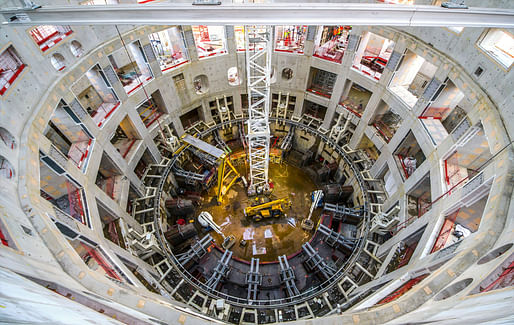

A Vinci-led consortium [...] completed civil engineering works on the high-spec building that will house the world’s largest fusion machine, called a “tokamak”, which scientists hope will start replicating the sun’s energy by the middle of the next decade. [...]
The 73-metre-high, 120-metre-wide structure required highly specific concretes. Teams developed about 10 formulations to shield staff and the environment from fusion-generated radiation.
— Global Construction Review
Building a tokamak machine to exploit fusion energy similar to our sun is no simple engineering feat: the building will house reactions that happen at extremely high temperatures, around 150 million degrees Celsius, fusing hydrogen nuclei when they reach the plasma state, thus releasing enormous amounts of energy in the process.
ITER, the international organization tasked with operating and subsequently dismantling the experimental facility, hopes to maintain its ambitious First Plasma target in 2025.
"Some parts of the Tokamak Building also called for steel reinforcement density rarely used on projects on this scale (up to 10 times the density of an apartment building wall)," explains a statement released by French contracting giant VINCI.
"[...] access to the heart of the Tokamak Building required customized production of 46 heavy nuclear doors. Each 70-tonne door is manufactured in Germany, brought to the site, filled with concrete and assembled in the heart of the Tokamak Building."
As the #CivilEngineering #work on the #ITER Tokamak Building comes to an end, take a look back at this journey that will help make the world’s biggest nuclear fusion project a reality in SE France @VINCIConstruc @VINCIEnergies pic.twitter.com/tizveYwvkN
— VINCI (@VINCI) November 8, 2019
While fusion power is still years, possibly decades, away from becoming a viable commercial energy source, its realization is being actively pursued by several research organizations around the world.
"Fusion is the true energy source of the future," praised Claudio Descalzi, CEO of Italian energy company Eni which is currently collaborating with MIT on another fusion project, adding, "it is completely sustainable, does not release emissions or long-term waste, and is potentially inexhaustible. It is a goal that we are increasingly determined to reach quickly."
1 Comment
IIRC this is the penultimate site of the quite excellent scifi/fantasy series Emperor of Thorns
Block this user
Are you sure you want to block this user and hide all related comments throughout the site?
Archinect
This is your first comment on Archinect. Your comment will be visible once approved.